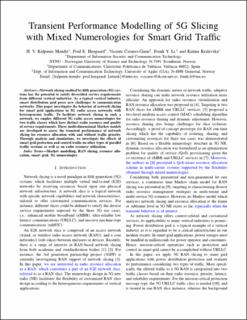| dc.contributor.author | Mendis, Handunneththi V. Kalpanie | |
| dc.contributor.author | Heegaard, Poul Einar | |
| dc.contributor.author | Casares-Giner, Vicente | |
| dc.contributor.author | Li, Frank Yong | |
| dc.contributor.author | Kralevska, Katina | |
| dc.date.accessioned | 2022-03-24T13:25:21Z | |
| dc.date.available | 2022-03-24T13:25:21Z | |
| dc.date.created | 2022-01-02T12:26:19Z | |
| dc.date.issued | 2021 | |
| dc.identifier.isbn | 978-1-6654-1779-2 | |
| dc.identifier.uri | https://hdl.handle.net/11250/2987417 | |
| dc.description.abstract | Network slicing enabled by fifth generation (5G) systems has the potential to satisfy diversified service requirements from different vertical industries. As a typical vertical industry, smart distribution grid poses new challenges to communication networks. This paper investigates the behavior of network slicing for smart grid applications in 5G radio access networks with heterogeneous traffic. To facilitate network slicing in such a network, we employ different 5G radio access numerologies for two traffic classes which have distinct radio resource and quality of service requirements. Three multi-dimensional Markov models are developed to assess the transient performance of network slicing for resource allocation with and without traffic priority. Through analysis and simulations, we investigate the effects of smart grid protection and control traffic on other types of parallel traffic sessions as well as on radio resource utilization. | en_US |
| dc.language.iso | eng | en_US |
| dc.publisher | Institute of Electrical and Electronics Engineers (IEEE) | en_US |
| dc.relation.ispartof | 2021 IEEE 26th International Workshop on Computer Aided Modeling and Design of Communication Links and Networks (CAMAD) | |
| dc.relation.uri | CINELDI - Centre for intelligent electricity distribution; A Massive MIMO Enabled IoT Platform with Networking Slicing for Beyond 5G IoV/V2X and Maritime Services (acronym: SOLID-B5G | |
| dc.title | Transient Performance Modelling of 5G Slicing with Mixed Numerologies for Smart Grid Traffic | en_US |
| dc.type | Chapter | en_US |
| dc.description.version | acceptedVersion | en_US |
| dc.rights.holder | © IEEE. Personal use of this material is permitted. Permission from IEEE must be obtained for all other uses, in any current or future media, including reprinting/republishing this material for advertising or promotional purposes, creating new collective works, for resale or redistribution to servers or lists, or reuse of any copyrighted component of this work in other works. | en_US |
| dc.source.pagenumber | 1-7 | en_US |
| dc.identifier.doi | 10.1109/CAMAD52502.2021.9617808 | |
| dc.identifier.cristin | 1973340 | |
| dc.relation.project | Norges forskningsråd: 257626/E20 | en_US |
| dc.relation.project | EØS - Det europeiske økonomiske samarbeidsområde: RO-NO-2019-0499, Project contract no. 42/2021 | en_US |
| cristin.ispublished | true | |
| cristin.fulltext | postprint | |
| cristin.qualitycode | 1 | |
